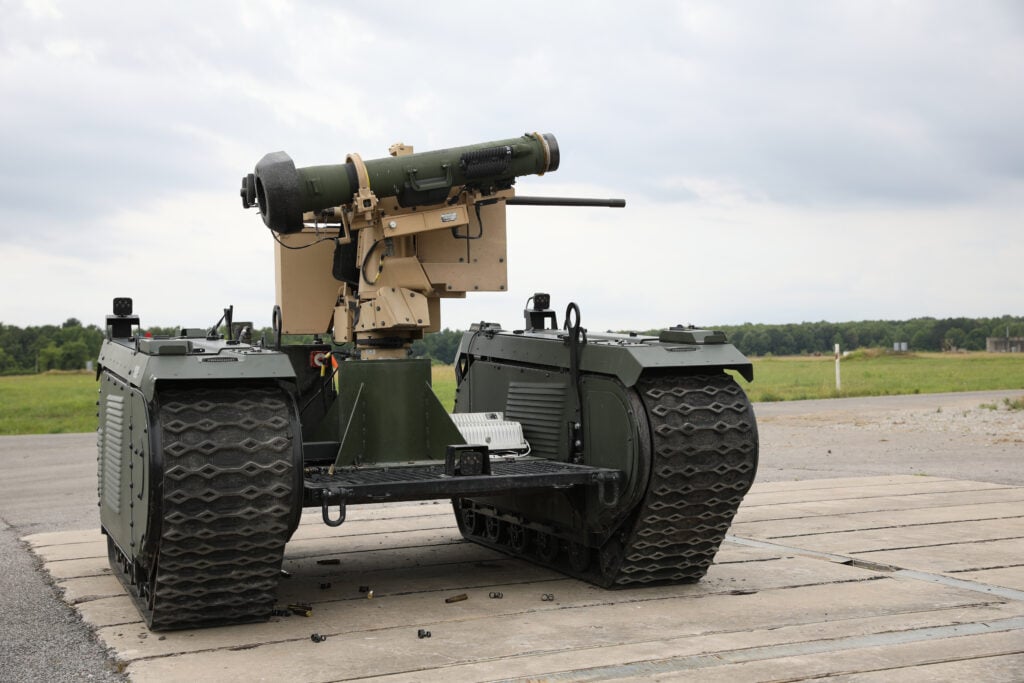Titan Robot Test-Fires Javelin Anti-Tank Missile
Posted on

QinetiQ Titan robot fitted with a Javelin anti-tank missile launcher
WASHINGTON: Imagine Russia’s armored legions rolling into the Baltic States. T-90 tanks lead BMPs packed with infantry through the rolling fields of Latvia. Then Javelin missiles streak from ambush positions in a treeline two miles away. The T-90s’ active protection systems and reactive armor shrug off some of the anti-tank warheads, but not all — and the lighter BMPs are decimated. Vehicles burn. Men die.

QinetiQ Titan robot firing a Javelin anti-tank missile launcher
The Russians retaliate with withering fire, first from the 125mm cannon on the tanks and then with a barrage of cluster bomblets from distant Katyushas. The ambushers cease fire.
But when the Russian troops advance cautiously between the smoldering stumps of trees, they find no bodies. Instead, there are faint tracks leading away, and a single burnt-out vehicle the size of a golf cart — equipped with a missile launcher, but no seats for human crew.
The US Army is exploring Robotic Combat Vehicles as adjuncts — not yet replacements — for its manned M1 Abrams tanks and the future Optionally Manned Fighting Vehicle to replace the Bradley.
There are “five-, 10-, and 20-ton vehicles we’re experimenting with, [on] not if, but how we’re going to use robots,” said the Army’s armor modernization director, Brig. Gen. Ross Coffman, at the recent Defense News conference. There’ll be major Robotic Combat Vehicle experiments in 2021, 2022, and 2023, “with decision points along the way for Army senior leaders” as to what they want to pursue, Coffman said.
Yesterday, a five-company collaboration announced a successful first step: A Titan unmanned ground vehicle — built by QinetiQ North America and Estonia-based Milrem Robotics — was fitted with a Kongsberg weapons platform that fired multiple Javelins — a joint product of Lockheed Martin and Raytheon — at targets on the Army’s Redstone range in Alabama.
Now, the Titan is not a “robot tank.” It does have tracks, the better to traverse rough terrain and boggy ground, but it weighs just about one ton and was originally designed to haul supplies for foot troops. The missile launcher is fired by remote control — by a human, not an algorithm (although there’s targeting tech in development that has the potential to change that). But after one shot, the robot can’t reload itself, so a human has to manhandle a new missile onto the launcher — for now. So this robot is no rival to the 70-ton M1 tank and its 120mm smoothbore gun, whose high-velocity shells no existing active protection system can stop.
But the Army’s not interested in a robotic M1, at least not in the near term. Instead, it’s looking at Robotic Combat Vehicles that could be much smaller, cheaper and more expendable than its manned vehicles — five, 10, or 20 tons, officials say– allowing them to play very different tactical roles.
One obvious mission for the robots is sacrificial delaying actions in the face of an overwhelming advance. Yes, human troops can also carry the Javelin, and trained infantry will probably be better at hiding than a robot, even a relatively small one like the one-ton Titan. But once those humans open fire, they will be targeted, and not all of them will make it out.
The QinetiQ-Kongsberg-Raytheon-Lockheed experiment isn’t officially in pursuit of any specific Army contract, a spokesperson said. It’s a proof of concept. (Milrem actually exhibited an earlier version of a Javelin-armed Titan, also with a Kongsberg weapon station, at last year’s AUSA conference, but there’s no report of that model being actually test-fired).
What it proves, first of all, is how easy this might be. The QinetiQ Titan was built to take different payloads, including remote-controlled weapons. What was added for this experiment was a modified version of the standard CROWS-J Javelin mount now being installed on the Army’s manned 8×8 Stryker vehicles. The difference is that, instead of being remote-controlled by a soldier within the vehicle, it’s being remote controlled by a soldier outside it. The tactical possibilities that opens up should give Army tacticians plenty of food for thought — and the Russians, perhaps, cause for caution.
Updated 8am with details on Milrem’s role.
Subscribe to our newsletter
Promotions, new products and sales. Directly to your inbox.
